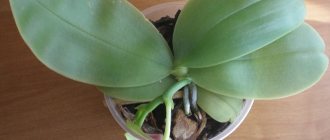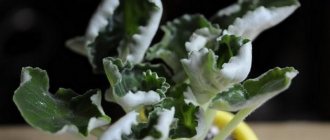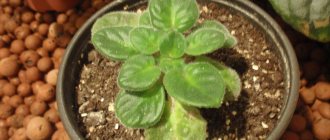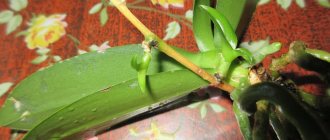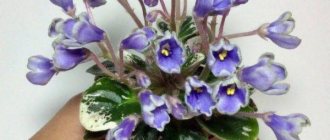Children grow up slowly
Moderator: Floriana
Children grow up slowly
Post by Frolochka » 08 Aug 2011, 11:47
Children grow up slowly
In May I bought three baby Saintpaulias. At first I planted it in bad soil and the children developed poorly, then I transferred it to new good soil, added more vermiculite there so that the soil was light, and now my children began to grow taller. but then two of them froze again, and one had already bloomed flowers. Tell me what to do?
Re: baby stunted
Post by Svyatoslav » 08 Aug 2011, 12:07
Re: Kids grow up slowly
Post by Elena M. » 09 Aug 2011, 10:58
Re: Kids grow up slowly
Post by Frolochka » 09 Aug 2011, 15:49
photos: this is what the third baby looks like
I bought all three in about this size
after re-transferring to improved soil, the children first grew in height, and now they have stopped. Varieties: EK-Snow Lace, EK-Cherry Blizzard
all three children grow up on the same window and in the same soil
Source
When and why do babies appear on violet leaves?
Children appear on violet leaves during vegetative propagation. First, a healthy leaf without defects is cut from a Saintpaulia bush of the selected variety that produces a cutting. Then it is rooted immediately in the ground or in water.
In the first option, the cut leaf is placed 1-2 cm into the soil and wait for its root system to form. If the second method is chosen, then the cutting is placed in a small container of water, into which 1 tablet of activated carbon is added for disinfection. When the leaf sprouts roots, it is transplanted into a nutrient substrate. After some time, sprouts will appear from the base of the cutting.
Appearance and quantity
Baby violets are similar to adult plants, only miniature. The young leaves of the sprouts repeat the shape and color of the cuttings. Only variegated varieties can produce white rosettes, but as the plants grow, it changes to green.
The number of children depends on the characteristics of the mother's leaf itself and the care for it. A cutting can produce up to 10 rosettes. Sometimes only 1 sprout appears from the ground or no shoots are observed at all.
How long does it take to appear
After planting, the cuttings take root within 2-3 weeks. After the formation of the root system, you can expect the appearance of violet babies. This will take another 1.5-3 months.
If after 3 months the petiole has not produced children, then no offspring will appear from it. To speed up the appearance of rosettes, you can cut off a third of the mother sheet.
External factors
External factors also play a role in the flowering process. Both heat and cold can destroy a flower. High temperatures above zero will cause the color to dry out. The heat will quickly dry out wet soil, harming the roots. On days like these, when the thermometer remains at high levels, you should spray or place a container of water next to the pot.
Why violet leaves turn yellow: causes and consequences
Low temperatures threaten the plant with the fact that it will not be able to survive the dormant period. The temperature should be kept above 17 °C.
Important! The most dangerous thing is sudden temperature changes. The painless difference should be no more than 3 °C.
What to do if children grow slowly
After the Saintpaulia cuttings have sprouted, some rosettes immediately begin to grow, while others sit in the ground almost unchanged. There may be several reasons why children grow slowly. The main factors influencing the development of rosettes are considered to be an unsuitable microclimate, untimely watering, too much or insufficient irrigation, fertilizing and the condition of the root system of young Saintpaulias.
If optimal temperature conditions are created for the shoots, additional artificial lighting is used in winter, the most suitable watering method is selected, and the young rosettes still do not grow, fertilizer should be applied to the cuttings. For young Saintpaulia rosettes, choose fertilizing with a high nitrogen content. The concentration of the solution should be 8 times lower than for adult plants.
Important! The most effective way to speed up the growth of any plant is to replant it. In this case, it is recommended to replace the substrate. For this, a new soil is prepared, consisting of peat, perlite, moss and wood ash. It should be light, nutritious and breathable.
If replanting also does not produce results, transferring it to a larger pot will help. Sometimes the cutting sends out too many shoots and they become crowded. In addition, the grown mother leaf can block light from young shoots. It should be cut off a little on top, and then transplanted together with the children into a container with a large diameter. You need to make sure that the Saintpaulias do not end up in the depths of the pot. With high sides it will be difficult for violets to develop.
Saintpaulia is sick
Disease is the most obvious reason why violets do not bloom. Even a novice florist can identify it by eye. To do this, when watering, you need to carefully examine the leaves for traces of infections and parasites.
So, what diseases are most common in violets?
- Fusarium . The violet does not bloom, the leaves turn gray and fall off, the roots are knocked out on top of the ground. The reason is improper care, excess moisture, watering with cold water. A fungus grows in the roots, causing the roots to rot. For prevention, spilling the soil with a solution of fundozol is used.
- Powdery mildew . Appears on leaves and stems in the form of a white coating. Fundozol and benlate are used in treatment.
- Gray rot and late blight . Appear from temperature changes and excessive watering, when leaves come into contact with the ground. With gray rot, a gray-brown coating appears and the plant turns white. Later the tissues begin to rot.
With late blight, brown spots appear on the leaves, which grow over time and can spread to the stem and flowers. The plant seems to be burning.
During treatment, diseased shoots and leaves are removed and treated with fungicides. If the plant dies, it is immediately thrown away along with the soil to avoid disease of other flowers.
How to seat children
To transplant young rosettes, the soil should not be wet, as there is a risk that heavy lumps of earth will tear off the thin and weak roots of the sprouts.
When separating the children from the cuttings, it may turn out that some rosettes have already formed a root system, while others have not yet had time to take root. They should not be thrown away. Such sprouts do not need to be separated; it is advisable to transplant them all together under a film. After some time, the shoots will take root, grow and cease to differ from their fellows.
If the cutting has only 1 child, you can plant the violet leaf along with it in another container without separating them. When the rosette grows, you should simply pinch off the leaf.
To properly separate the babies from the cuttings, you should take all the shoots in one hand and the mother leaf in the other. Then try to slowly and effortlessly separate them. After this, the sockets will easily fall apart from each other, and they can be transplanted into a separate container.
When to replant
When determining the time for separation of children from the mother leaf, the size and age of the shoots does not play a big role. Here, each variety has its own timing when replanting mature rosettes is allowed, and when you need to wait. The procedure can be carried out if the violet baby has several formed roots.
Most often, young rosettes are transplanted when they have sprouted 2-3 leaves and reached a height of 4-5 cm. Children of miniature Saintpaulias are planted later. If there is no risk of deformation of the rosettes through a large number of them, you can wait to separate them from the mother sheet for up to six months.
What to do with white kids
Children from variegated varieties often turn out completely white. There is no need to rush to transplant them. First you need to wait for the rosettes to grow a little and at least some of them acquire a green tint.
Only in this case can you separate the babies from the cuttings. If the white rosettes of Saintpaulia are taken from the mother leaf without waiting for changes, they will die.
Seating technology
The method of plant transplantation consists of the following algorithm of actions:
After transplanting young rosettes, all containers with them are placed in a special polymer greenhouse or plastic bags with zippers. For ventilation, you need to make punctures in the cellophane or do not close the shelter tightly. You can purchase a greenhouse at a flower shop or use a food-grade plastic container with a lid for this purpose.
With regular moisture and fertilization, a healthy plant will grow. 7-10 days after separation of the violet babies from the leaf, they can be accustomed to the conditions of further existence. Periodically, you should open the greenhouse or cellophane and leave the sockets in this state for some time, gradually increasing its duration.
What to do if there are many children
If the cutting has produced a large number of children, you need to decide whether it is worth keeping them all. First you need to determine what variety the mother leaf belongs to. If it is a fancy violet that is a sporting violet, it is recommended that all rosettes be left. They need to be transplanted into separate containers and wait until flowering to select the required specimens.
If the Saintpaulia variety does not go into sport when using vegetative propagation, then the grower himself has the right to decide how many shoots to leave for further cultivation.
How to separate and plant large children
If the cuttings produce rosettes of unequal size, then first you can separate and replant only the larger specimens in a separate container. It is better to leave small sprouts near the mother leaf so that they grow and become stronger.
To separate larger rosettes, take the cuttings with the babies from the container, place the earthen ball with the leaves on a horizontal surface and carefully separate the selected shoots. Then we return the leaf with the remaining sprouts back to the pot, adding a little soil. We place large children in disposable plastic cups and place them in a greenhouse.
How to care for children
There are several rules for growing young Saintpaulia rosettes. These recommendations should be carefully followed, since the plant is considered quite capricious to care for.
Overfilling water is worse for children than not filling it enough. Excess moisture is fraught with rotting of the unformed root system of violets. Therefore, it is better to use a syringe or medical syringe to moisten the soil. Irrigation should be started only when the earthen ball on top dries out. When watering from above, you need to make sure that drops of moisture do not fall on the young leaves, otherwise brown spots will soon form in these places.
You can build wick irrigation, then the root system of the sprouts will absorb only the required amount of moisture. For irrigation, it is recommended to use melted, rain or settled tap water at room temperature.
The temperature in the room should be maintained at +22°C. It is not recommended to raise the parameter higher, as this will lead to a decrease in air humidity, which will immediately affect the condition of young Saintpaulias.
Young rosettes of violets are in dire need of good lighting, so in winter it is recommended to install an additional lighting source near the rack with them. Periodically, containers with Saintpaulia should be rotated so that the sun's rays fall on them evenly. This will help to form a bush of the correct shape.
Violets do not need to be fertilized for the first 3 months after transplanting into new soil. After this time, it will be possible to periodically apply fertilizer. It is advisable to use complex liquid preparations, strictly following the dosage.
To maintain optimal balance in the soil, it is recommended to alternate organic and mineral fertilizers. Before fertilizing, lightly moisten the soil so as not to burn the roots of the plant with the prepared solution.
Incorrect watering
Poor watering is also the reason for the lack of flowering. Excessively dry or wet soil or incorrect water temperature will not allow inflorescences to form. There are 3 methods for setting it up:
- installing a gauze wick in the pot during the transplant process. With its help, the plant will take from the reservoir as much water as it needs for a comfortable existence;
- watering at the root. It is important to prevent water from getting on the plant itself, otherwise it may rot. It is necessary to water with settled, lukewarm water;
- adding water to the pan, from where the soil will absorb the water on its own, and then removing moisture from it to prevent rotting of the roots.
Reasons for the absence of children
The reason why a violet leaf does not produce children may be due to the cuttings being planted too deeply. The shoots formed at its base simply cannot hatch through the thickness of the soil.
The problem of why cuttings do not produce children for a long time may also be hidden in the composition of the soil. The soil for vegetative propagation should be loose and breathable, then there is a greater chance that the leaf will sprout.
Sometimes flower growers decide to radically combat the problem of lack of offspring. If the children do not grow, what do they do: re-cut and root the mother leaf. The chances of success with this method increase significantly.
Source
From the experience of collectors. From leaf to baby
You have purchased new varieties or simply decided to propagate your favorite violets using leaf cuttings. The question arises - what is the most correct, convenient and faster way to root them?
Since 2000, we have tried many methods for propagating violets using leaf cuttings and want to share the most convenient and favorite options for us.
If you took a cutting from your healthy plant, you can begin rooting without any preliminary steps. If you received it from someone else’s collection, it is advisable to wash the leaf in a weak (pale pink) solution of potassium permanganate - this will remove possible microorganisms.
If the cutting has lost its elasticity, for example, after a long shipment, it is necessary to completely immerse it in water for a while until it acquires normal turgor (on average for several hours).
The question arises: what is the best way to root - directly into the substrate or first germinate in water? For an experienced violet grower there is no difference (we plant directly in the substrate). But for a novice amateur, we would still advise you to first put the leaf in water. If he doesn’t like something and the cutting starts to rot, you will immediately see it and be able to update the cut and root it again. In the substrate, there is a chance that you will not notice it in time.
According to our observations, cuttings produce roots well in both transparent and opaque containers (glass, plastic). However, cuttings do not form roots in a crystal container!
What kind of water should I take? We rooted in boiled water, in ordinary water from the tap (settled for 1 day), and in a weak solution of complex fertilizer - the result was good in all cases. We tried to take water passed through a household filter - the majority of the cuttings did not produce roots.
If you are rooting a cutting in water, it is not necessary to place it under a plastic bag (greenhouse). Watch the leaf carefully: if everything is fine, tender roots will appear in 2 weeks. Don't wait for them to outgrow: 0.5-1 cm is enough to transplant the cuttings into the substrate. If the cut begins to rot, make a new cut, wash it in a weak solution of potassium permanganate and place it in a clean container with another water.
There is an excellent method of rooting (it is also suitable for capricious varieties that stubbornly do not want to grow roots in water): take sphagnum moss, fresh (from the forest) or stored raw, and place it loosely in a plastic bag. Leaves are laid flat on it, the cuts are symbolically covered with moss. We tie the bag tightly (ziplock bags work well), put it in a warm (24ºC) place, lighting does not play a special role during rooting. With this method, the roots are thick and all equally developed. This will take the same 2 weeks. If you pay attention, you will notice that the moss began to grow during this time. This suggests that it actively secretes sphagnol (a bactericidal phenol-like substance), and, apparently, this is why the cuttings practically do not rot.
So, your cutting has roots. What will you grow it in next? We tried several substrates. Growing in chopped sphagnum moss on wick irrigation with a microfertilizer solution has proven to work well. There are a lot of children, they are well developed. For regular irrigation, it is better to use a mixture of cut sphagnum moss in half with red weathered peat. The results are also very good. If you root in substrates that contain any soil, the percentage of rotting cuttings increases. A prerequisite (regardless of the composition of the substrate) is to place the cuttings in a greenhouse or under a plastic bag.
Many people use peat tablets for rooting. For those who do not have a very large number of violets, this is a convenient way.
If the cutting has successfully taken root, feels good, but does not want to produce babies, you need to stimulate it! To do this, we usually cut off the top third of the sheet. As a rule, this helps - after a while, children appear.
Features of rooting directly into the substrate. Before rooting, make a fresh oblique cut. The length of the petiole is approximately 3 cm, which is buried 1-1.5 cm into the substrate at an angle. The substrate should be sufficiently moist, but not too wet. To prevent the leaf from losing excess moisture, cover it with a plastic bag. Cuttings root well at temperatures above 20 degrees. On average, roots appear after 2-3 weeks. Depending on the variety, children are formed within 1.5-3 months from planting. According to our observations, if a cutting does not produce children for more than three months, then, as a rule, there will be no offspring from it.
In some varieties with curly leaves, the children, growing up, begin to rest against the lower part of the leaf. We advise cutting off these “curls” so that they do not interfere with the development of the younger generation.
In our experience, the size and “age” of the baby are not decisive when separating from the cuttings - each variety has its own period. The main thing is that the child develops at least a few roots of his own. Then the separation from the parent will be successful. Usually, from the rooting of the cutting to the separation of the baby, an average of 2-3 months passes.
There may be this option: when several children are separated from the cuttings, some of them already have roots, while others do not. Do not throw away the babies: plant several of them in one pot and cover them with film - the same way as all the separated babies. Most of the little ones will take root and will soon catch up with their larger brothers.
If a leaf has only one baby, you can plant them together in a pot without separating them for some time. Then you can simply pinch off the leaf.
To properly separate the babies from the cuttings, grab all the babies at once in one hand, and the cuttings in the other. And, gently rocking, separate them. After this, the children separate from each other very easily.
Children from variegated varieties often appear completely white. You must wait until they grow up and at least some of the leaves become green - only after that they can be removed from the cuttings. Otherwise, white babies will die without the nutrients that are produced with the help of chlorophyll.
The mixture for replanting the baby will depend on how you plan to water the plant. If it is wick irrigation, then we recommend using a soilless mixture. If watering is normal, then you can use the following mixture: one part of leaf or garden soil, one part of cut sphagnum moss and one part of weathered red peat. With sufficient watering and regular feeding on such a substrate, you will grow a beautiful, healthy plant.
Approximately 10 days after separation, the baby must begin to be accustomed to the conditions where it will grow further: periodically we open the cellophane slightly and observe its condition.
At this stage, you can already guess what to expect from the baby. For example, pay attention to the unusual shape or color of the leaves - most likely such plants will not bloom according to the variety. However, sometimes the sport can turn out to be much more interesting than the variety. But the best thing about propagating violets using leaf cuttings is that each leaf usually produces several children, most of which will bloom according to the variety!
Source
Pest Control
Another problem is pests. Like diseases, they can lead to the death of a plant, since the main food for pests is the juices contained in the flower.
Why do violet leaves curl inward?
Signs of pests:
- their location on the leaves or below them;
- plaque that appears on the leaf;
- pinpoint spots caused by bites.
The most famous pests include scale insects, aphids, and mites. To combat them, it is necessary to treat the plant with Actillic or Fitoverm.
Important! Washing using a soap solution is contraindicated. The lint that covers the violet stems interferes with proper washing.
If you start the process of removing harmful insects, you can bring the plant first to a weakened state, then to complete withering. Deprived of juice, the leaves will begin to dry, turn yellow, and rot. Dark spots will appear on the surface of the foliage. In this state, the violet will never bloom.
Pest prevention
Having completed all the steps to save color from pests, we must not forget about prevention.
- New flowers are kept in quarantine for two to three weeks.
- Violets are kept at a short distance from each other so that their leaves do not touch.
- From time to time, the plant is given a bath in warm water.
- Dried flowers and dry foliage are cut off in a timely manner.
- Arrange wet cleaning of places where flower pots are located.
Pests interfere with the appearance of buds
All about violet babies: photos and descriptions
Saintpaulia uzumbarica is better known among flower lovers as indoor violet. The plant is represented by numerous varieties, which differ in a variety of colors, terry size and shape of the petals.
To create an entire collection, all you need to do is grow your favorite violet yourself. To do this, need one leaf and following the recommendations for rooting it .
We will tell you later in our article how to grow such a young plant and how long it takes for the babies to bloom after planting.
Basic Concepts
In this article we tried to collect the most necessary and interesting information for violet growers :
kids
Most often, violets are propagated by leaf cuttings - a fresh leaf that is separated from the mother plant. Once rooted in the ground, it is called a rooted leaf (cutting). It is already stress-resistant and is able to grow without greenhouse conditions.
Some time after planting, babies develop at the base of the cuttings - small plants with their own root system. They can grow independently and bear all the characteristics of an adult plant. When the baby forms 2-3 pairs of leaves the size of a marigold, it is planted.
And if the violet babies don’t grow, what should you do? We'll talk about this below.
Stepchildren
Sometimes a small plant, a stepson, develops in the axil of the leaves. They are especially often formed before the violet blooms.
To prevent them from deforming the rosette, it is better to remove them at the earliest stages of development .
Starter
The grown-up baby turns into a starter - a teenage plant. It is not blooming yet, but is already closer to an adult violet.
How to grow a baby from a leaf?
Growing a violet yourself is quite simple; the main thing is to know the basic requirements for rooting a cutting.
Material selection
The choice of planting material is a crucial moment in violet propagation:
Leaves from the lower tier of the rosette are not suitable for rooting , they are usually old and in this case the violet does not produce children for a long time.
Rooting
Both methods of propagation are quite effective , but in the second case, almost 100% rooting of cuttings is achieved and the time for germination of children is reduced, since the leaf is planted immediately in a permanent place.
Rooting in soil is more effective than in water.
In the soil
To root the cutting, first prepare a container and an earthen mixture. Violet loves a light, nutrient-poor substrate with good aeration. To plant cuttings, it is prepared in advance:
To plant the leaf you will also need:
When everything is prepared, you can start planting the cuttings :
In water
The main positive aspect of germinating cuttings in water is the ease of monitoring the formation and health of the root system :
The timing of rooting is determined by the violet variety and cultivation temperature. When the roots reach a length of 1-2 cm, the cuttings are planted in an earthen mixture.
Development conditions
Until the children have sprouted, the plant should be in greenhouse conditions:
After the babies are formed, the violet is grown at room temperature.
Deadlines
How long it takes for a violet to produce babies largely depends on its variety and cultivation temperature :
In some cases, flower growers make mistakes that lead to prolonged formation and weakening of the babies.
The reasons why violet babies grow slowly are:
Keeping cuttings in a greenhouse speeds up the appearance of babies.
In addition, during the season of short daylight hours, the risk of leaf rotting increases.
When and how to separate them?
When considering the timing of when to separate the children from the violet leaf, it should be taken into account that they must build up sufficient root mass. This will happen in about three months, when they reach four to five centimeters in diameter (for mini varieties 1-3 cm). After that, they are seated in cups.
The procedure itself, how to separate a violet baby from the mother leaf , is as follows:
At first, the transplanted plants are kept in a greenhouse, after which they are accustomed to the conditions of an apartment.
Treatment options
Biostimulants for growth
It is not always possible to ensure full compliance with the optimal conditions for keeping Saintpaulia at home. To help plants survive difficult times, it is permissible to use growth regulators and stimulants.
They are used to support plant immunity throughout the year. They help survive poor lighting and low temperatures in winter, heat and drought in summer. Biostimulants promote faster growth of violets, improve metabolic processes, and increase resistance to disease.
Biogrowth stimulants help plants in critical situations.
Unlike fertilizers, such preparations can be used at the first signs of “ill health” in Saintpaulia . It is best to carry out treatment with a certain frequency for the purpose of prevention and boosting immunity.
The use of phytohormones is also justified, helping cuttings to quickly acquire their own root system. But they are by no means a panacea for all diseases and pests.
The use of stimulants is justified for:
- increasing immunity;
- stimulating the growth of Saintpaulia, the appearance of buds and flowering;
- support for weakened and diseased plants;
- rooting.
Attention! The use of these drugs loses its meaning against the backdrop of erroneous agricultural techniques and non-compliance with the conditions of detention.
Stimulants, as a rule, have a narrowly targeted effect:
- Heteroauxin – increases the rate of cell division, delays their aging, accelerates the synthesis of ribonucleic acids;
- Epin – initiates biochemical transformations, stimulates protein synthesis, activates photosynthesis;
- Zircon – increases the absorption of water and nutrients by the root system, increases the rate of photosynthesis;
- Gibberellins - accelerate cell division at the top of the stem, increase the growth rate of leaves and flowers. They act more intensely than auxins.
The use of phytohormones and stimulants
The most popular phytohormones and growth stimulants used to reduce side effects from transplantation or due to improper care:
- Heteroauxin . Used when transplanting violets and rooting cuttings, as it is responsible for root growth;
- Epin or Epin-extra increases immunity and increases stress resistance under adverse conditions. It increases resistance to late blight, bacteriosis and fusarium. Epin is dissolved in slightly acidified water;
- the action of Zircon almost completely coincides with Epin. In addition, it is used for root growth and plant survival. Zircon is stronger than Epin. You can not only spray flowers with it, but also water it at the root. Violets watered with zircon should be provided with good lighting to enhance the process of photosynthesis;
When using Zircon, violets need a lot of light.
- the use of Gibberellin should be accompanied by good lighting and increased fertilizing for the growth of green mass.
Whether or not to use phytohormones and growth stimulants is up to each collector to decide for himself. There are situations when their use is not only justified, but also necessary.
Reproduction by stepson
In order for a violet to form a rosette of the correct shape, it needs one growing point . From time to time, daughter plants - stepchildren - develop from the buds located between the leaves.
Usually the stepsons are removed (plucked off), but they can also be used for propagation . The formation of stepsons on violets can be stimulated:
Such manipulations initiate the growth of a large number of stepchildren.
This method of propagation is especially relevant for chimeric varieties , which transmit hereditary information only by vegetative means (parts of the plant).
Reproduction by stepsons is the most suitable method for chimeras.
When and how to separate?
Stepson who is ready to separate:
They separate it with a sharp knife and immediately place it on rooting, which can be done in several ways.
Rooting and stages of development
There are three ways to root stepchildren:
Caring for young violets
After the babies have been seated in cups and the stepchildren have taken root, they still need care. During this period, young plants are more sensitive to light - they love diffused light, preferring northern and north-eastern windows.
Priming
Grown-up children, 4-5 cm in diameter with two or three pairs of leaves, are transplanted into a special earthen mixture. As with cuttings, it should be light and poor in nutrients.
An example would be the composition: nutrient soil for violets mixed with high-moor peat (poor in nutrients) and filler (perlite, foam balls, etc.) in a ratio of 1:2:1.
The soil for violet babies should be quite loose.
As the children grow, they are transplanted into larger containers with a diameter of 7-8 cm, and then 9-10 cm.
Features of watering
The watering regime largely depends on the violet growing conditions . The flower should not be over-dried or over-watered:
In conditions of low temperature, the amount of watering is reduced.
Through the wick
Wick watering allows the plant to regulate its own moisture supply depending on environmental conditions:
With such watering there is a minimal risk of developing root rot.
Top dressing
Violet babies are not fed. Only a month after separation from the cuttings, fertilizer with a high nitrogen content can be applied to a small plant. After 3-4 months, fertilizing should contain more phosphorus and less nitrogen.
Pot size and soil composition
Ready-made soil for violets can be purchased at every gardening store. Or you can do it yourself. Ideally, the composition should include turf, coniferous, leaf and peat soil. We must not forget about leavening agents: perlite, vermiculite, sphagnum or river sand.
The home beauty doesn't like a big pot. Since in nature it grows on rocky soil, its bark system is located on the surface of the soil. Therefore, deep and wide pots are not needed for it. The diameter of the pot should be one or two centimeters smaller than the flower itself, if you straighten its leaves.
Following these simple rules will give you the opportunity to decorate your home with beautiful and delicate flowers.
Author: Svetlana Protas
